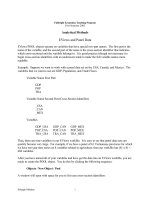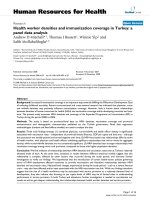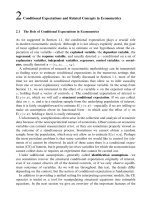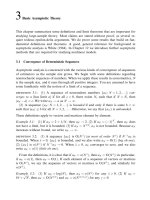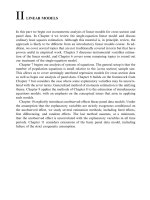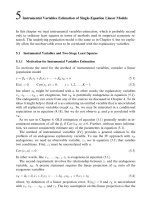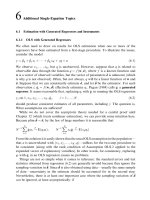Book -- Longitudinal and Panel Data Analysis
Bạn đang xem bản rút gọn của tài liệu. Xem và tải ngay bản đầy đủ của tài liệu tại đây (3.55 MB, 485 trang )
P1: KNP/FFX
CB733-FM
P2: GDZ/FFX
QC: GDZ/FFX
T1: GDZ
CB733-Frees-v4
June 18, 2004
This page intentionally left blank
ii
14:23
P1: KNP/FFX
CB733-FM
P2: GDZ/FFX
QC: GDZ/FFX
T1: GDZ
CB733-Frees-v4
June 18, 2004
Longitudinal and Panel Data
This book focuses on models and data that arise from repeated observations of a cross
section of individuals, households, or firms. These models have found important applications within business, economics, education, political science, and other social science
disciplines.
The author introduces the foundations of longitudinal and panel data analysis at
a level suitable for quantitatively oriented graduate social science students as well as
individual researchers. He emphasizes mathematical and statistical fundamentals but
also describes substantive applications from across the social sciences, showing the
breadth and scope that these models enjoy. The applications are enhanced by real-world
data sets and software programs in SAS, Stata, and R.
EDWARD W. FREES
is Professor of Business at the University of Wisconsin–Madison
and is holder of the Fortis Health Insurance Professorship of Actuarial Science. He is
a Fellow of both the Society of Actuaries and the American Statistical Association.
He has served in several editorial capacities including Editor of the North American
Actuarial Journal and Associate Editor of Insurance: Mathematics and Economics. An
award-winning researcher, he has published in the leading refereed academic journals in
actuarial science and insurance, other areas of business and economics, and mathematical
and applied statistics.
i
14:23
P1: KNP/FFX
CB733-FM
P2: GDZ/FFX
QC: GDZ/FFX
T1: GDZ
CB733-Frees-v4
June 18, 2004
ii
14:23
P1: KNP/FFX
CB733-FM
P2: GDZ/FFX
QC: GDZ/FFX
T1: GDZ
CB733-Frees-v4
June 18, 2004
Longitudinal and Panel Data
Analysis and Applications in the Social Sciences
EDWARD W. FREES
University of Wisconsin–Madison
iii
14:23
cambridge university press
Cambridge, New York, Melbourne, Madrid, Cape Town, Singapore, São Paulo
Cambridge University Press
The Edinburgh Building, Cambridge cb2 2ru, UK
Published in the United States of America by Cambridge University Press, New York
www.cambridge.org
Information on this title: www.cambridge.org/9780521828284
© Edward W. Frees 2004
This publication is in copyright. Subject to statutory exception and to the provision of
relevant collective licensing agreements, no reproduction of any part may take place
without the written permission of Cambridge University Press.
First published in print format 2004
isbn-13
isbn-10
978-0-511-21169-0 eBook (EBL)
0-511-21346-8 eBook (EBL)
isbn-13
isbn-10
978-0-521-82828-4 hardback
0-521-82828-7 hardback
isbn-13
isbn-10
978-0-521-53538-0 paperback
0-521-53538-7 paperback
Cambridge University Press has no responsibility for the persistence or accuracy of urls
for external or third-party internet websites referred to in this publication, and does not
guarantee that any content on such websites is, or will remain, accurate or appropriate.
P1: KNP/FFX
CB733-FM
P2: GDZ/FFX
QC: GDZ/FFX
T1: GDZ
CB733-Frees-v4
June 18, 2004
Contents
Preface
1
2
3
4
page ix
Introduction
1.1 What Are Longitudinal and Panel Data?
1.2 Benefits and Drawbacks of Longitudinal Data
1.3 Longitudinal Data Models
1.4 Historical Notes
Fixed-Effects Models
2.1 Basic Fixed-Effects Model
2.2 Exploring Longitudinal Data
2.3 Estimation and Inference
2.4 Model Specification and Diagnostics
2.5 Model Extensions
Further Reading
Appendix 2A. Least-Squares Estimation
Exercises and Extensions
Models with Random Effects
3.1 Error-Components/Random-Intercepts Model
3.2 Example: Income Tax Payments
3.3 Mixed-Effects Models
3.4 Inference for Regression Coefficients
3.5 Variance Components Estimation
Further Reading
Appendix 3A. REML Calculations
Exercises and Extensions
Prediction and Bayesian Inference
4.1 Estimators versus Predictors
4.2 Predictions for One-Way ANOVA Models
v
1
1
5
12
15
18
18
24
31
38
46
52
53
57
72
72
81
86
94
100
106
107
113
125
125
126
14:23
P1: KNP/FFX
CB733-FM
P2: GDZ/FFX
QC: GDZ/FFX
T1: GDZ
CB733-Frees-v4
vi
5
6
7
8
June 18, 2004
Contents
4.3 Best Linear Unbiased Predictors
4.4 Mixed-Model Predictors
4.5 Example: Forecasting Wisconsin Lottery Sales
4.6 Bayesian Inference
4.7 Credibility Theory
Further Reading
Appendix 4A. Linear Unbiased Prediction
Exercises and Extensions
Multilevel Models
5.1 Cross-Sectional Multilevel Models
5.2 Longitudinal Multilevel Models
5.3 Prediction
5.4 Testing Variance Components
Further Reading
Appendix 5A. High-Order Multilevel Models
Exercises and Extensions
Stochastic Regressors
6.1 Stochastic Regressors in Nonlongitudinal
Settings
6.2 Stochastic Regressors in Longitudinal Settings
6.3 Longitudinal Data Models with Heterogeneity Terms
and Sequentially Exogenous Regressors
6.4 Multivariate Responses
6.5 Simultaneous-Equations Models with Latent
Variables
Further Reading
Appendix 6A. Linear Projections
Modeling Issues
7.1 Heterogeneity
7.2 Comparing Fixed- and Random-Effects Estimators
7.3 Omitted Variables
7.4 Sampling, Selectivity Bias, and Attrition
Exercises and Extensions
Dynamic Models
8.1 Introduction
8.2 Serial Correlation Models
8.3 Cross-Sectional Correlations and Time-Series
Cross-Section Models
8.4 Time-Varying Coefficients
8.5 Kalman Filter Approach
129
133
138
147
152
156
157
159
166
166
174
180
184
187
187
191
199
199
208
213
221
231
240
240
242
242
247
256
263
272
277
277
280
286
288
295
14:23
P1: KNP/FFX
CB733-FM
P2: GDZ/FFX
QC: GDZ/FFX
T1: GDZ
CB733-Frees-v4
June 18, 2004
Contents
8.6 Example: Capital Asset Pricing Model
Appendix 8A. Inference for the Time-Varying
Coefficient Model
9 Binary Dependent Variables
9.1 Homogeneous Models
9.2 Random-Effects Models
9.3 Fixed-Effects Models
9.4 Marginal Models and GEE
Further Reading
Appendix 9A. Likelihood Calculations
Exercises and Extensions
10 Generalized Linear Models
10.1 Homogeneous Models
10.2 Example: Tort Filings
10.3 Marginal Models and GEE
10.4 Random-Effects Models
10.5 Fixed-Effects Models
10.6 Bayesian Inference
Further Reading
Appendix 10A. Exponential Families of Distributions
Exercises and Extensions
11 Categorical Dependent Variables and Survival Models
11.1 Homogeneous Models
11.2 Multinomial Logit Models with Random Effects
11.3 Transition (Markov) Models
11.4 Survival Models
Appendix 11A. Conditional Likelihood Estimation for
Multinomial Logit Models with Heterogeneity Terms
Appendix A Elements of Matrix Algebra
A.1 Basic Terminology
A.2 Basic Operations
A.3 Additional Definitions
A.4 Matrix Decompositions
A.5 Partitioned Matrices
A.6 Kronecker (Direct) Product
Appendix B Normal Distribution
B.1 Univariate Normal Distribution
B.2 Multivariate Normal Distribution
B.3 Normal Likelihood
B.4 Conditional Distributions
vii
302
312
318
318
329
335
339
343
344
347
350
350
356
360
366
371
376
380
380
386
387
387
398
400
411
415
417
417
418
418
419
420
421
422
422
422
423
423
14:23
P1: KNP/FFX
CB733-FM
P2: GDZ/FFX
QC: GDZ/FFX
T1: GDZ
CB733-Frees-v4
viii
June 18, 2004
Contents
Appendix C Likelihood-Based Inference
C.1 Characteristics of Likelihood Functions
C.2 Maximum Likelihood Estimators
C.3 Iterated Reweighted Least Squares
C.4 Profile Likelihood
C.5 Quasi-Likelihood
C.6 Estimating Equations
C.7 Hypothesis Tests
C.8 Goodness-of-Fit Statistics
C.9 Information Criteria
Appendix D State Space Model and the Kalman Filter
D.1 Basic State Space Model
D.2 Kalman Filter Algorithm
D.3 Likelihood Equations
D.4 Extended State Space Model and Mixed Linear Models
D.5 Likelihood Equations for Mixed Linear Models
Appendix E Symbols and Notation
Appendix F Selected Longitudinal and Panel Data Sets
References
Index
424
424
425
426
427
427
428
431
432
433
434
434
435
436
436
437
439
445
451
463
14:23
P1: KNP/FFX
CB733-FM
P2: GDZ/FFX
QC: GDZ/FFX
T1: GDZ
CB733-Frees-v4
June 18, 2004
Preface
Intended Audience and Level
This text focuses on models and data that arise from repeated measurements
taken from a cross section of subjects. These models and data have found
substantive applications in many disciplines within the biological and social
sciences. The breadth and scope of applications appears to be increasing over
time. However, this widespread interest has spawned a hodgepodge of terms;
many different terms are used to describe the same concept. To illustrate, even
the subject title takes on different meanings in different literatures; sometimes
this topic is referred to as “longitudinal data” and sometimes as “panel data.”
To welcome readers from a variety of disciplines, the cumbersome yet more
inclusive descriptor “longitudinal and panel data” is used.
This text is primarily oriented to applications in the social sciences. Thus, the
data sets considered here come from different areas of social science including
business, economics, education, and sociology. The methods introduced in the
text are oriented toward handling observational data, in contrast to data arising
from experimental situations, which are the norm in the biological sciences.
Even with this social science orientation, one of my goals in writing this
text is to introduce methodology that has been developed in the statistical and
biological sciences, as well as the social sciences. That is, important methodological contributions have been made in each of these areas; my goal is to
synthesize the results that are important for analyzing social science data, regardless of their origins. Because many terms and notations that appear in this
book are also found in the biological sciences (where panel data analysis is
known as longitudinal data analysis), this book may also appeal to researchers
interested in the biological sciences.
Despite a forty-year history and widespread usage, a survey of the literature shows that the quality of applications is uneven. Perhaps this is because
ix
14:23
P1: KNP/FFX
CB733-FM
P2: GDZ/FFX
QC: GDZ/FFX
T1: GDZ
CB733-Frees-v4
x
June 18, 2004
Preface
longitudinal and panel data analysis has developed in separate fields of inquiry;
what is widely known and accepted in one field is given little prominence in a
related field. To provide a treatment that is accessible to researchers from a variety of disciplines, this text introduces the subject using relatively sophisticated
quantitative tools, including regression and linear model theory. Knowledge of
calculus, as well as matrix algebra, is also assumed. For Chapter 8 on dynamic
models, a time-series course at the level of Box, Jenkins, and Reinsel (1994G)
would also be useful.
With this level of prerequisite mathematics and statistics, I hope that the text
is accessible to my primary audience: quantitatively oriented graduate social
science students. To help students work through the material, the text features
several analytical and empirical exercises. Moreover, detailed appendices on
different mathematical and statistical supporting topics should help students
develop their knowledge of the topic as they work the exercises. I also hope that
the textbook style, such as the boxed procedures and an organized set of symbols
and notation, will appeal to applied researchers who would like a reference text
on longitudinal and panel data modeling.
Organization
The beginning chapter sets the stage for the book. Chapter 1 introduces longitudinal and panel data as repeated observations from a subject and cites examples
from many disciplines in which longitudinal data analysis is used. This chapter
outlines important benefits of longitudinal data analysis, including the ability
to handle the heterogeneity and dynamic features of the data. The chapter also
acknowledges some important drawbacks of this scientific methodology, particularly the problem of attrition. Furthermore, Chapter 1 provides an overview
of the several types of models used to handle longitudinal data; these models are
considered in greater detail in subsequent chapters. This chapter should be read
at the beginning and end of one’s introduction to longitudinal data analysis.
When discussing heterogeneity in the context of longitudinal data analysis, we mean that observations from different subjects tend to be dissimilar
when compared to observations from the same subject, which tend to be similar. One way of modeling heterogeneity is to use fixed parameters that vary
by individual; this formulation is known as a fixed-effects model and is described in Chapter 2. A useful pedagogic feature of fixed-effects models is that
they can be introduced using standard linear model theory. Linear model and
regression theory is widely known among research analysts; with this solid
foundation, fixed-effects models provide a desirable foundation for introducing
14:23
P1: KNP/FFX
CB733-FM
P2: GDZ/FFX
QC: GDZ/FFX
T1: GDZ
CB733-Frees-v4
June 18, 2004
Preface
xi
longitudinal data models. This text is written assuming that readers are familiar
with linear model and regression theory at the level of, for example, Draper and
Smith (1981G) or Greene (2002E). Chapter 2 provides an overview of linear
models with a heavy emphasis on analysis of covariance techniques that are
useful for longitudinal and panel data analysis. Moreover, the Chapter 2 fixedeffects models provide a solid framework for introducing many graphical and
diagnostic techniques.
Another way of modeling heterogeneity is to use parameters that vary by
individual yet that are represented as random quantities; these quantities are
known as random effects and are described in Chapter 3. Because models with
random effects generally include fixed effects to account for the mean, models
that incorporate both fixed and random quantities are known as linear mixedeffects models. Just as a fixed-effects model can be thought of in the linear
model context, a linear mixed-effects model can be expressed as a special case
of the mixed linear model. Because mixed linear model theory is not as widely
known as regression, Chapter 3 provides more details on the estimation and
other inferential aspects than the corresponding development in Chapter 2.
Still, the good news for applied researchers is that, by writing linear mixedeffects models as mixed linear models, widely available statistical software can
be used to analyze linear mixed-effects models.
By appealing to linear model and mixed linear model theory in Chapters 2
and 3, we will be able to handle many applications of longitudinal and panel
data models. Still, the special structure of longitudinal data raises additional
inference questions and issues that are not commonly addressed in the standard
introductions to linear model and mixed linear model theory. One such set of
questions deals with the problem of “estimating” random quantities, known as
prediction. Chapter 4 introduces the prediction problem in the longitudinal data
context and shows how to “estimate” residuals, conditional means, and future
values of a process. Chapter 4 also shows how to use Bayesian inference as an
alternative method for prediction.
To provide additional motivation and intuition for Chapters 3 and 4, Chapter
5 introduces multilevel modeling. Multilevel models are widely used in educational sciences and developmental psychology where one assumes that complex
systems can be modeled hierarchically; that is, modeling is done one level at
a time, with each level conditional on lower levels. Many multilevel models
can be written as linear mixed-effects models; thus, the inference properties of
estimation and prediction that we develop in Chapters 3 and 4 can be applied
directly to the Chapter 5 multilevel models.
Chapter 6 returns to the basic linear mixed-effects model but adopts an
econometric perspective. In particular, this chapter considers situations where
14:23
P1: KNP/FFX
CB733-FM
P2: GDZ/FFX
QC: GDZ/FFX
T1: GDZ
CB733-Frees-v4
xii
June 18, 2004
Preface
the explanatory variables are stochastic and may be influenced by the response
variable. In such circumstances, the explanatory variables are known as endogenous. Difficulties associated with endogenous explanatory variables, and
methods for addressing these difficulties, are well known for cross-sectional
data. Because not all readers will be familiar with the relevant econometric
literature, Chapter 6 reviews these difficulties and methods. Moreover, Chapter
6 describes the more recent literature on similar situations for longitudinal data.
Chapter 7 analyzes several issues that are specific to a longitudinal or panel
data study. One issue is the choice of the representation to model heterogeneity.
The many choices include fixed-effects, random-effects, and serial correlation
models. Chapter 7 also reviews important identification issues when trying to
decide upon the appropriate model for heterogeneity. One issue is the comparison of fixed- and random-effects models, a topic that has received substantial
attention in the econometrics literature. As described in Chapter 7, this comparison involves interesting discussions of the omitted-variables problem. Briefly,
we will see that time-invariant omitted variables can be captured through the
parameters used to represent heterogeneity, thus handling two problems at the
same time. Chapter 7 concludes with a discussion of sampling and selectivity
bias. Panel data surveys, with repeated observations on a subject, are particularly susceptible to a type of selectivity problem known as attrition, where
individuals leave a panel survey.
Longitudinal and panel data applications are typically “long” in the cross
section and “short” in the time dimension. Hence, the development of these
methods stems primarily from regression-type methodologies such as linear
model and mixed linear model theory. Chapters 2 and 3 introduce some dynamic aspects, such as serial correlation, where the primary motivation is to
provide improved parameter estimators. For many important applications, the
dynamic aspect is the primary focus, not an ancillary consideration. Further, for
some data sets, the temporal dimension is long, thus providing opportunities
to model the dynamic aspect in detail. For these situations, longitudinal data
methods are closer in spirit to multivariate time-series analysis than to crosssectional regression analysis. Chapter 8 introduces dynamic models, where the
time dimension is of primary importance.
Chapters 2 through 8 are devoted to analyzing data that may be represented
using models that are linear in the parameters, including linear and mixed linear models. In contrast, Chapters 9 through 11 are devoted to analyzing data
that can be represented using nonlinear models. The collection of nonlinear
models is vast. To provide a concentrated discussion that relates to the applications orientation of this book, we focus on models where the distribution of
the response cannot be reasonably approximated by a normal distribution and
alternative distributions must be considered.
14:23
P1: KNP/FFX
CB733-FM
P2: GDZ/FFX
QC: GDZ/FFX
T1: GDZ
CB733-Frees-v4
June 18, 2004
Preface
xiii
We begin in Chapter 9 with a discussion of modeling responses that are
dichotomous; we call these binary dependent-variable models. Because not all
readers with a background in regression theory have been exposed to binary
dependent models such as logistic regression, Chapter 9 begins with an introductory section under the heading of “homogeneous” models; these are simply the
usual cross-sectional models without heterogeneity parameters. Then, Chapter
9 introduces the issues associated with random- and fixed-effects models to accommodate the heterogeneity. Unfortunately, random-effects model estimators
are difficult to compute and the usual fixed-effects model estimators have undesirable properties. Thus, Chapter 9 introduces an alternative modeling
strategy that is widely used in biological sciences based on a so-called marginal
model. This model employs generalized estimating equations (GEE) or generalized method of moments (GMM) estimators that are simple to compute and
have desirable properties.
Chapter 10 extends that Chapter 9 discussion to generalized linear models
(GLMs). This class of models handles the normal-based models of Chapters
2–8, the binary models of Chapter 9, and additional important applied models.
Chapter 10 focuses on count data through the Poisson distribution, although
the general arguments can also be used for other distributions. Like Chapter 9,
we begin with the homogeneous case to provide a review for readers who have
not been introduced to GLMs. The next section is on marginal models that are
particularly useful for applications. Chapter 10 follows with an introduction to
random- and fixed-effects models.
Using the Poisson distribution as a basis, Chapter 11 extends the discussion to multinomial models. These models are particularly useful in economic
“choice” models, which have seen broad applications in the marketing research
literature. Chapter 11 provides a brief overview of the economic basis for these
choice models and then shows how to apply these to random-effects multinomial models.
Statistical Software
My goal in writing this text is to reach a broad group of researchers. Thus, to
avoid excluding large segments of the readership, I have chosen not to integrate
any specific statistical software package into the text. Nonetheless, because
of the applications orientation, it is critical that the methodology presented be
easily accomplished using readily available packages. For the course taught at
the University of Wisconsin, I use the statistical package SAS. (However, many
of my students opt to use alternative packages such as Stata and R. I encourage
free choice!) In my mind, this is the analog of an “existence theorem.” If a
14:23
P1: KNP/FFX
CB733-FM
P2: GDZ/FFX
QC: GDZ/FFX
T1: GDZ
CB733-Frees-v4
June 18, 2004
xiv
Preface
procedure is important and can be readily accomplished by one package, then
it is (or will soon be) available through its competitors. On the book Web site,
/>users will find routines written in SAS for the methods advocated in the text, thus
demonstrating that they are readily available to applied researchers. Routines
written for Stata and R are also available on the Web site. For more information
on SAS, Stata, and R, visit their Web sites:
,
, and
.
References Codes
In keeping with my goal of reaching a broad group of researchers, I have attempted to integrate contributions from different fields that regularly study longitudinal and panel data techniques. To this end, the references are subdivided
into six sections. This subdivision is maintained to emphasize the breadth of
longitudinal and panel data analysis and the impact that it has made on several
scientific fields. I refer to these sections using the following coding scheme:
B:
E:
EP:
O:
S:
G:
Biological Sciences Longitudinal Data,
Econometrics Panel Data,
Educational Science and Psychology,
Other Social Sciences,
Statistical Longitudinal Data, and
General Statistics.
For example, I use “Neyman and Scott (1948E)” to refer to an article written by
Neyman and Scott, published in 1948, that appears in the “Econometrics Panel
Data” portion of the references.
Approach
This book grew out of lecture notes for a course offered at the University
of Wisconsin. The pedagogic approach of the manuscript evolved from the
course. Each chapter consists of an introduction to the main ideas in words and
then as mathematical expressions. The concepts underlying the mathematical
14:23
P1: KNP/FFX
CB733-FM
P2: GDZ/FFX
QC: GDZ/FFX
T1: GDZ
CB733-Frees-v4
June 18, 2004
Preface
xv
expressions are then reinforced with empirical examples; these data are available
to the reader at the Wisconsin book Web site. Most chapters conclude with exercises that are primarily analytic; some are designed to reinforce basic concepts
for (mathematically) novice readers. Others are designed for (mathematically)
sophisticated readers and constitute extensions of the theory presented in the
main body of the text. The beginning chapters (2–5) also include empirical
exercises that allow readers to develop their data analysis skills in a longitudinal data context. Selected solutions to the exercises are also available from the
author.
Readers will find that the text becomes more mathematically challenging
as it progresses. Chapters 1–3 describe the fundamentals of longitudinal data
analysis and are prerequisites for the remainder of the text. Chapter 4 is prerequisite reading for Chapters 5 and 8. Chapter 6 contains important elements
necessary for reading Chapter 7. As already mentioned, a time-series analysis
course would also be useful for mastering Chapter 8, particularly Section 8.5
on the Kalman filter approach.
Chapter 9 begins the section on nonlinear modeling. Only Chapters 1–3 are
necessary background for this section. However, because it deals with nonlinear
models, the requisite level of mathematical statistics is higher than Chapters
1–3. Chapters 10 and 11 continue the development of these models. I do not
assume prior background on nonlinear models. Thus, in Chapters 9–11, the
first section introduces the chapter topic in a nonlongitudinal context called a
homogeneous model.
Despite the emphasis placed on applications and interpretations, I have not
shied from using mathematics to express the details of longitudinal and panel
data models. There are many students with excellent training in mathematics and
statistics who need to see the foundations of longitudinal and panel data models.
Further, there are now available a number of texts and summary articles (which
are cited throughout the text) that place a heavier emphasis on applications.
However, applications-oriented texts tend to be field-specific; studying only
from such a source can mean that an economics student will be unaware of
important developments in educational sciences (and vice versa). My hope is
that many instructors will chose to use this text as a technical supplement to an
applications-oriented text from their own field.
The students in my course come from the wide variety of backgrounds in
mathematical statistics. To develop longitudinal and panel data analysis tools
and achieve a common set of notation, most chapters contain a short appendix
that develops mathematical results cited in the chapter. In addition, there are
four appendices at the end of the text that expand mathematical developments
used throughout the text. A fifth appendix, on symbols and notation, further
14:23
P1: KNP/FFX
CB733-FM
P2: GDZ/FFX
QC: GDZ/FFX
T1: GDZ
CB733-Frees-v4
xvi
June 18, 2004
Preface
summarizes the set of notation used throughout the text. The sixth appendix
provides a brief description of selected longitudinal and panel data sets that are
used in several disciplines throughout the world.
Acknowledgments
This text was reviewed by several generations of longitudinal and panel data
classes here at the University of Wisconsin. The students in my classes contributed a tremendous amount of input into the text; their input drove the text’s
development far more than they realize.
I have enjoyed working with several colleagues on longitudinal and panel
data problems over the years. Their contributions are reflected indirectly
throughout the text. Moreover, I have benefited from detailed reviews by Anocha
Ariborg, Mousumi Banerjee, Jee-Seon Kim, Yueh-Chuan Kung, and Georgios
Pitelis. Thanks also to Doug Bates for introducing me to R.
Moreover, I am happy to acknowledge financial support through the Fortis
Health Professorship in Actuarial Science.
Saving the most important for last, I thank my family for their support. Ten
thousand thanks go to my mother Mary, my wife Deirdre, our sons Nathan and
Adam, and the family source of amusement, our dog Lucky.
14:23
P1: GDZ/FFX
0521828287c01
P2: GDZ/FFX
QC: GDZ/FFX
T1: GDZ
CB733-Frees-v4
May 25, 2004
1
Introduction
Abstract. This chapter introduces the many key features of the data and
models used in the analysis of longitudinal and panel data. Here, longitudinal and panel data are defined and an indication of their widespread
usage is given. The chapter discusses the benefits of these data; these include opportunities to study dynamic relationships while understanding,
or at least accounting for, cross-sectional heterogeneity. Designing a longitudinal study does not come without a price; in particular, longitudinal
data studies are sensitive to the problem of attrition, that is, unplanned exit
from a study. This book focuses on models appropriate for the analysis
of longitudinal and panel data; this introductory chapter outlines the set
of models that will be considered in subsequent chapters.
1.1 What Are Longitudinal and Panel Data?
Statistical Modeling
Statistics is about data. It is the discipline concerned with the collection, summarization, and analysis of data to make statements about our world. When
analysts collect data, they are really collecting information that is quantified,
that is, transformed to a numerical scale. There are many well-understood rules
for reducing data, using either numerical or graphical summary measures. These
summary measures can then be linked to a theoretical representation, or model,
of the data. With a model that is calibrated by data, statements about the world
can be made.
As users, we identify a basic entity that we measure by collecting information
on a numerical scale. This basic entity is our unit of analysis, also known as the
research unit or observational unit. In the social sciences, the unit of analysis is
typically a person, firm, or governmental unit, although other applications can
1
7:54
P1: GDZ/FFX
0521828287c01
P2: GDZ/FFX
QC: GDZ/FFX
T1: GDZ
CB733-Frees-v4
2
May 25, 2004
1 Introduction
and do arise. Other terms used for the observational unit include individual, from
the econometrics literature, as well as subject, from the biostatistics literature.
Regression analysis and time-series analysis are two important applied statistical methods used to analyze data. Regression analysis is a special type of
multivariate analysis in which several measurements are taken from each subject. We identify one measurement as a response, or dependent variable; our
interest is in making statements about this measurement, controlling for the
other variables.
With regression analysis, it is customary to analyze data from a cross section
of subjects. In contrast, with time-series analysis, we identify one or more
subjects and observe them over time. This allows us to study relationships over
time, the dynamic aspect of a problem. To employ time-series methods, we
generally restrict ourselves to a limited number of subjects that have many
observations over time.
Defining Longitudinal and Panel Data
Longitudinal data analysis represents a marriage of regression and time-series
analysis. As with many regression data sets, longitudinal data are composed of
a cross section of subjects. Unlike regression data, with longitudinal data we
observe subjects over time. Unlike time-series data, with longitudinal data we
observe many subjects. Observing a broad cross section of subjects over time
allows us to study dynamic, as well as cross-sectional, aspects of a problem.
The descriptor panel data comes from surveys of individuals. In this context,
a “panel” is a group of individuals surveyed repeatedly over time. Historically,
panel data methodology within economics had been largely developed through
labor economics applications. Now, economic applications of panel data methods are not confined to survey or labor economics problems and the interpretation of the descriptor “panel analysis” is much broader. Hence, we will use the
terms “longitudinal data” and “panel data” interchangeably although, for simplicity, we often use only the former term.
Example 1.1: Divorce Rates Figure 1.1 shows the 1965 divorce rates versus
AFDC (Aid to Families with Dependent Children) payments for the fifty states.
For this example, each state represents an observational unit, the divorce rate is
the response of interest, and the level of AFDC payment represents a variable
that may contribute information to our understanding of divorce rates.
The data are observational; thus, it is not appropriate to argue for a causal
relationship between welfare payments (AFDC) and divorce rates without invoking additional economic or sociological theory. Nonetheless, their relation
is important to labor economists and policymakers.
7:54
P1: GDZ/FFX
0521828287c01
P2: GDZ/FFX
QC: GDZ/FFX
T1: GDZ
CB733-Frees-v4
May 25, 2004
1.1 What Are Longitudinal and Panel Data?
3
DIVORCE
6
5
4
3
2
1
0
20
40
60
80
100
120
140
160
180
200
220
AFDC
Figure 1.1. Plot of 1965 divorce rates versus AFDC payments.
(Source: Statistical Abstract of the United States.)
Figure 1.1 shows a negative relation; the corresponding correlation coefficient is −.37. Some argue that this negative relation is counterintuitive in that
one would expect a positive relation between welfare payments and divorce
rates; states with desirable economic climates enjoy both a low divorce rate
and low welfare payments. Others argue that this negative relationship is intuitively plausible; wealthy states can afford high welfare payments and produce
a cultural and economic climate conducive to low divorce rates.
Another plot, not displayed here, shows a similar negative relation for 1975;
the corresponding correlation is −.425. Further, a plot with both the 1965
and 1975 data displays a negative relation between divorce rates and AFDC
payments.
Figure 1.2 shows both the 1965 and 1975 data; a line connects the two observations within each state. These lines represent a change over time (dynamic),
not a cross-sectional relationship. Each line displays a positive relationship;
that is, as welfare payments increase so do divorce rates for each state. Again,
we do not infer directions of causality from this display. The point is that the
dynamic relation between divorce and welfare payments within a state differs
dramatically from the cross-sectional relationship between states.
Some Notation
Models of longitudinal data are sometimes differentiated from regression and
time-series data through their double subscripts. With this notation, we may
7:54
P1: GDZ/FFX
0521828287c01
P2: GDZ/FFX
QC: GDZ/FFX
T1: GDZ
CB733-Frees-v4
May 25, 2004
4
1 Introduction
DIVORCE
10
8
6
4
2
0
0
100
200
300
400
AFDC
Figure 1.2. Plot of divorce rate versus AFDC payments from 1965 and 1975.
distinguish among responses by subject and time. To this end, define yit to be
the response for the ith subject during the tth time period. A longitudinal data
set consists of observations of the ith subject over t = 1, . . . , Ti time periods,
for each of i = 1, . . . , n subjects. Thus, we observe
first subject − {y11 , y12 , . . . , y1T1 }
second subject − {y21 , y22 , . . . , y2T2 }
..
.
nth subject − {yn1 , yn2 , . . . , ynTn }.
In Example 1.1, most states have Ti = 2 observations and are depicted graphically in Figure 1.2 by a line connecting the two observations. Some states have
only Ti = 1 observation and are depicted graphically by an open-circle plotting
symbol. For many data sets, it is useful to let the number of observations depend
on the subject; Ti denotes the number of observations for the ith subject. This
situation is known as the unbalanced data case. In other data sets, each subject
has the same number of observations; this is known as the balanced data case.
Traditionally, much of the econometrics literature has focused on the balanced
data case. We will consider the more broadly applicable unbalanced data case.
Prevalence of Longitudinal and Panel Data Analysis
Longitudinal and panel databases and models have taken on important roles in
the literature. They are widely used in the social science literature, where panel
data are also known as pooled cross-sectional time series, and in the natural
sciences, where panel data are referred to as longitudinal data. To illustrate
7:54
P1: GDZ/FFX
0521828287c01
P2: GDZ/FFX
QC: GDZ/FFX
T1: GDZ
CB733-Frees-v4
1.2 Benefits and Drawbacks of Longitudinal Data
May 25, 2004
5
their prevalence, consider that an index of business and economic journals,
ABI/INFORM, lists 326 articles in 2002 and 2003 that use panel data methods.
Another index of scientific journals, the ISI Web of Science, lists 879 articles
in 2002 and 2003 that use longitudinal data methods. Note that these are only
the applications that were considered innovative enough to be published in
scholarly reviews.
Longitudinal data methods have also developed because important databases
have become available to empirical researchers. Within economics, two important surveys that track individuals over repeated surveys include the Panel
Survey of Income Dynamics (PSID) and the National Longitudinal Survey
of Labor Market Experience (NLS). In contrast, the Consumer Price Survey
(CPS) is another survey conducted repeatedly over time. However, the CPS is
generally not regarded as a panel survey because individuals are not tracked
over time. For studying firm-level behavior, databases such as Compustat and
CRSP (University of Chicago’s Center for Research on Security Prices) have
been available for over thirty years. More recently, the National Association
of Insurance Commissioners (NAIC) has made insurance company financial
statements available electronically. With the rapid pace of software development within the database industry, it is easy to anticipate the development of
many more databases that would benefit from longitudinal data analysis. To
illustrate, within the marketing area, product codes are scanned in when customers check out of a store and are transferred to a central database. These
scanner data represent yet another source of data information that may inform
marketing researchers about purchasing decisions of buyers over time or the
efficiency of a store’s promotional efforts. Appendix F summarizes longitudinal
and panel data sets used worldwide.
1.2 Benefits and Drawbacks of Longitudinal Data
There are several advantages of longitudinal data compared with either purely
cross-sectional or purely time-series data. In this introductory chapter, we focus
on two important advantages: the ability to study dynamic relationships and to
model the differences, or heterogeneity, among subjects. Of course, longitudinal
data are more complex than purely cross-sectional or times-series data and so
there is a price to pay in working with them. The most important drawback is the
difficulty in designing the sampling scheme to reduce the problem of subjects
leaving the study prior to its completion, known as attrition.
Dynamic Relationships
Figure 1.1 shows the 1965 divorce rate versus welfare payments. Because these
are data from a single point in time, they are said to represent a static relationship.
7:54
P1: GDZ/FFX
0521828287c01
P2: GDZ/FFX
QC: GDZ/FFX
T1: GDZ
CB733-Frees-v4
6
May 25, 2004
1 Introduction
For example, we might summarize the data by fitting a line using the method
of least squares. Interpreting the slope of this line, we estimate a decrease of
0.95% in divorce rates for each $100 increase in AFDC payments.
In contrast, Figure 1.2 shows changes in divorce rates for each state based
on changes in welfare payments from 1965 to 1975. Using least squares, the
overall slope represents an increase of 2.9% in divorce rates for each $100
increase in AFDC payments. From 1965 to 1975, welfare payments increased
an average of $59 (in nominal terms) and divorce rates increased 2.5%. Now
the slope represents a typical time change in divorce rates per $100 unit time
change in welfare payments; hence, it represents a dynamic relationship.
Perhaps the example might be more economically meaningful if welfare
payments were in real dollars, and perhaps not (for example, deflated by the
Consumer Price Index). Nonetheless, the data strongly reinforce the notion that
dynamic relations can provide a very different message than cross-sectional
relations.
Dynamic relationships can only be studied with repeated observations, and
we have to think carefully about how we define our “subject” when considering
dynamics. Suppose we are looking at the event of divorce on individuals. By
looking at a cross section of individuals, we can estimate divorce rates. By
looking at cross sections repeated over time (without tracking individuals),
we can estimate divorce rates over time and thus study this type of dynamic
movement. However, only by tracking repeated observations on a sample of
individuals can we study the duration of marriage, or time until divorce, another
dynamic event of interest.
Historical Approach
Early panel data studies used the following strategy to analyze pooled crosssectional data:
r Estimate cross-sectional parameters using regression.
r Use time-series methods to model the regression parameter estimators,
treating estimators as known with certainty.
Although useful in some contexts, this approach is inadequate in others, such as
Example 1.1. Here, the slope estimated from 1965 data is −0.95%. Similarly,
the slope estimated from 1975 data turns out to be −1.0%. Extrapolating these
negative estimators from different cross sections yields very different results
from the dynamic estimate: a positive 2.9%. Theil and Goldberger (1961E)
provide an early discussion of the advantages of estimating the cross-sectional
and time-series aspects simultaneously.
7:54
P1: GDZ/FFX
0521828287c01
P2: GDZ/FFX
QC: GDZ/FFX
T1: GDZ
CB733-Frees-v4
May 25, 2004
1.2 Benefits and Drawbacks of Longitudinal Data
7
Dynamic Relationships and Time-Series Analysis
When studying dynamic relationships, univariate time-series analysis is a welldeveloped methodology. However, this methodology does not account for relationships among different subjects. In contrast, multivariate time-series analysis
does account for relationships among a limited number of different subjects.
Whether univariate or multivariate, an important limitation of time-series analysis is that it requires several (generally, at least thirty) observations to make
reliable inferences. For an annual economic series with thirty observations, using time-series analysis means that we are using the same model to represent
an economic system over a period of thirty years. Many problems of interest
lack this degree of stability; we would like alternative statistical methodologies
that do not impose such strong assumptions.
Longitudinal Data as Repeated Time Series
With longitudinal data we use several (repeated) observations of many subjects.
Repeated observations from the same subject tend to be correlated. One way to
represent this correlation is through dynamic patterns. A model that we use is
the following:
yit = Eyit + εit ,
t = 1, . . . , Ti , i = 1, . . . , n,
(1.1)
where εit represents the deviation of the response from its mean; this deviation
may include dynamic patterns. Further, the symbol E represents the expectation
operator so that Eyit is the expected response. Intuitively, if there is a dynamic
pattern that is common among subjects, then by observing this pattern over many
subjects, we hope to estimate the pattern with fewer time-series observations
than required of conventional time-series methods.
For many data sets of interest, subjects do not have identical means. As a
first-order approximation, a linear combination of known, explanatory variables
such as
Eyit = α + xit β
serves as a useful specification of the mean function. Here, xit is a vector of
explanatory, or independent, variables.
Longitudinal Data as Repeated Cross-Sectional Studies
Longitudinal data may be treated as a repeated cross section by ignoring the
information about individuals that is tracked over time. As mentioned earlier,
there are many important repeated surveys such as the CPS where subjects
are not tracked over time. Such surveys are useful for understanding aggregate
changes in a variable, such as the divorce rate, over time. However, if the interest
7:54
